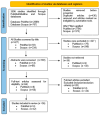Behind-the-Scenes Actors in Fertility: A Comprehensive Review of the Female Reproductive Tract Microbiome and Its Clinical Relevance
- PMID: 40566568
- PMCID: PMC12193755
- DOI: 10.3390/life15060916
Behind-the-Scenes Actors in Fertility: A Comprehensive Review of the Female Reproductive Tract Microbiome and Its Clinical Relevance
Abstract
The study of the microbiome has rapidly progressed over the past few decades, capturing the interest of both scientists and the general public. Nevertheless, there is still no widely agreed-upon definition for the term "microbiome" despite tremendous advances in our knowledge. The international scientific literature consistently underscores the difference between the human microbiome and human microbiota. Recent research has emphasized the importance of the female reproductive tract microbiome in fertility, impacting natural conception and assisted reproductive technologies (ARTs). This review explores the relationship between infertility and the microbiota of the female reproductive tract through a thorough evaluation of research papers and large-scale studies published up to 2024. The objective of this review is to critically assess current evidence on the role of the reproductive tract microbiome in female infertility and ART outcomes. Relevant papers were identified and analyzed through the electronic medical databases PubMed/MEDLINE and Scopus. A comprehensive synthesis of data from 36 original studies was performed, including observational, case-control, cohort, and randomized trials. By focusing on the vagina, cervix, and endometrium, this study offers a comprehensive overview of the microbiome throughout the female reproductive tract. RIF and poor reproductive outcomes are strongly linked to dysbiosis, which is characterized by a reduction in Lactobacillus species. Lactobacillus crispatus, in particular, plays a significant role in protecting against bacterial vaginosis and infertility. A thorough understanding of how the microbiome impacts fertility and the development of clinical strategies to improve reproductive outcomes requires standardized microbiome investigation techniques and larger, randomized trials that account for diverse patient characteristics.
Keywords: Lactobacillus; female infertility; female reproductive system; microbiome; microbiota.
Conflict of interest statement
The authors declare no conflicts of interest.
Figures



Similar articles
-
Health professionals' experience of teamwork education in acute hospital settings: a systematic review of qualitative literature.JBI Database System Rev Implement Rep. 2016 Apr;14(4):96-137. doi: 10.11124/JBISRIR-2016-1843. JBI Database System Rev Implement Rep. 2016. PMID: 27532314
-
Metabolomics as a tool to identify biomarkers to predict and improve outcomes in reproductive medicine: a systematic review.Hum Reprod Update. 2017 Nov 1;23(6):723-736. doi: 10.1093/humupd/dmx023. Hum Reprod Update. 2017. PMID: 29069503
-
In vivo oxygen, temperature and pH dynamics in the female reproductive tract and their importance in human conception: a systematic review.Hum Reprod Update. 2018 Jan 1;24(1):15-34. doi: 10.1093/humupd/dmx028. Hum Reprod Update. 2018. PMID: 29077897
-
Application of seminal plasma to female genital tract prior to embryo transfer in assisted reproductive technology cycles (IVF, ICSI and frozen embryo transfer).Cochrane Database Syst Rev. 2018 Feb 28;2(2):CD011809. doi: 10.1002/14651858.CD011809.pub2. Cochrane Database Syst Rev. 2018. PMID: 29489026 Free PMC article.
-
Antioxidants for male subfertility.Cochrane Database Syst Rev. 2022 May 4;5(5):CD007411. doi: 10.1002/14651858.CD007411.pub5. Cochrane Database Syst Rev. 2022. PMID: 35506389 Free PMC article.
Cited by
-
Reproductive Health and Assisted Conception in Celiac Disease and Non-Celiac Gluten Sensitivity: A Narrative Review.Nutrients. 2025 Jul 3;17(13):2215. doi: 10.3390/nu17132215. Nutrients. 2025. PMID: 40647319 Free PMC article. Review.
References
-
- Moreno I., Garcia-Grau I., Perez-Villaroya D., Gonzalez-Monfort M., Bahceci M., Barrionuevo M.J., Taguchi S., Puente E., Dimattina M., Lim M.W., et al. Endometrial microbiota composition is associated with reproductive outcome in infertile patients. Microbiome. 2022;10:1. doi: 10.1186/s40168-021-01184-w. - DOI - PMC - PubMed
-
- Kaltsas A., Zikopoulos A., Vrachnis D., Skentou C., Symeonidis E.N., Dimitriadis F., Stavros S., Chrisofos M., Sofikitis N., Vrachnis N., et al. Advanced Paternal Age in Focus: Unraveling Its Influence on Assisted Reproductive Technology Outcomes. J. Clin. Med. 2024;13:2731. doi: 10.3390/jcm13102731. - DOI - PMC - PubMed
Publication types
LinkOut - more resources
Full Text Sources
Miscellaneous

